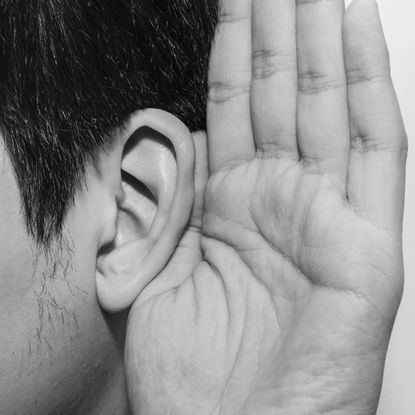The subtle sounds that English speakers have trouble catching
The "p" in pit, is not the same as the one in spit


You've probably noticed how speakers of some languages can't seem to tell certain sounds apart. As a result, they can confuse word pairs such as wet and vet, beat and bit, thin and tin, or long and wrong.
But have you noticed how you do the same kind of thing? You and everyone who speaks English?
It's not simply that there are some sounds we don't make in English. It's that there are sounds we actually make, but we think they're the same as some other sounds. Here's your guide to some pairs of sounds that other languages treat as different sounds, but we in English treat as the same — and may not even hear the difference.
Subscribe to The Week
Escape your echo chamber. Get the facts behind the news, plus analysis from multiple perspectives.

Sign up for The Week's Free Newsletters
From our morning news briefing to a weekly Good News Newsletter, get the best of The Week delivered directly to your inbox.
From our morning news briefing to a weekly Good News Newsletter, get the best of The Week delivered directly to your inbox.
Pit vs. spit
Perhaps the most classic example in English of treating two different sounds as the same sound without even noticing it is a thing linguists call aspiration. When we say a voiceless stop — "p," "t," "k" — at the very start of a stressed syllable, we say a puff of air after it. If we say it elsewhere, we don't — even if it's at the beginning of a syllable but just has an s before it. Try this: hold your hand or a piece of tissue in front of your mouth. Say "pit." Notice a puff of air after the p? Now say "spit." No puff. Say "happen." Also no puff. And yet we think of the p with aspiration (the puff) and the one without it as the same sound — they're what linguists call allophones of the same phoneme (a phoneme is something that's thought of as a distinct sound in a given language).
In Mandarin, Thai, Hindi, and several other languages, they don't think of those two p's as the same phoneme. They use different letters for them, and the difference is often represented in Latin-alphabet transliteration by writing an h after the aspirated one. For example, in Hindi, phal (that's p as in pit plus al as in dual) means "fruit," while pal (that's p as in spit and otherwise the same) means "moment." Those two words are what linguists call a minimal pair: the only thing that tells you which one you're hearing is that one difference between phonemes.
Front and back versions of u/oo
Sign up for Today's Best Articles in your inbox
A free daily email with the biggest news stories of the day – and the best features from TheWeek.com
If your reaction to discovering allophones is "Duuuude! That's so cooool!" you may have just given an example of what linguists call free variation. Sometimes instead of saying the u in dude like the one in nuke or the oo in cool, we say it farther forward in the mouth, more like "dewd," perhaps in imitation of some stereotypical "surfer dude" accent. We can hear the difference, but we don't think that this "dewd"-like version is a different word from the one we say like "dood." But if we spoke French, German, or any of several other languages, we would see those as two different vowels. In French, that difference in vowel sound is the only difference between, for example, au dessus (on top) and au dessous (underneath).
The three l's
Know what else is cool? Like, really cool? And maybe a little vulgar? How about a three-way...distinction between phonemes, that is. The l in cool is not the same as the l in like, and neither of them is the same as the l in vulgar. When we think of an l we think of the one at the start of like, with the tip of your tongue touching near the front. But when it's at the end of a syllable, as in cool, the back of your tongue arches up a bit at the same time. And when it's before a consonant that touches at the back, as in vulgar or balcony, we very often don't even touch the tip of the tongue to the palate, so it's more like a w without the lips being rounded.
Who makes a distinction between these? I don't know what language uses all three, but quite a few languages make a distinction between at least two of them. In Irish Gaelic, leag (the e is silent and just indicates which l is being used) uses the like one and means "knock down," while lag uses the cool one and means "weak." In Sm'algyax (also known as Coastal Tsimshan), a language of northwestern British Columbia and southern Alaska, ts'aal uses the like one and is a verb meaning "filet fish," while ts'aaẅ uses the vulgar one (represented by ẅ) and is a noun meaning "guts."
The lazy v
Another free variation we have in English is what we might call the proper versus lazy way of saying sounds such as "v." If you read that popular catering company slogan "Savor the flavor" but say it quickly or lazily, you may not quite touch your teeth to your lip on the v's. Well, guess what: if you were speaking Dutch, you'd be saying a different letter. Dutch v is like English v, though sometimes they say it as "f," but Dutch w isn't like English w (except in some dialects); it's like those lazy v's. That little difference is how the Dutch tell apart wat (what) and vat (barrel or grip). What? Oh, get a grip.
The glottal stop
It's common in English to reduce a "t" in many places to just a glottal stop. We often do it at the end of a word such as butt or what, especially at the end of a sentence — check to see if your tongue tip actually touches when you say it. In some British accents, you hear the glottal stop even in the middle of a word such as butter. We also sometimes use a glottal stop at the beginning of a word next to a vowel, not to represent "t" but just for a crisper sound. But in many languages around the world, that glottal stop is a phoneme in its own right.
You'll find this in Hawai'ian and several other Polynesian languages. Hawai'ian is an especially interesting case because, while it treats a glottal stop as a distinct phoneme, it doesn't make a difference between "t" and "k" — it treats them as the same sound, and when you see a k in Hawai'ian it could be said as "k" or "t." So when you see maka, which means "eye" or "face," it could also be said "mata." But when you see ma'a, which means "accustomed to," it's like "ah-ah" with an m to start — never like "mata."
Creaky voice
There's a popular hate-in lately for what may have heard called "vocal fry" — that creaky or clicky drawling voice sound that many people make when lowering their voices or trailing off at the end of a sentence. Phonologists usually call it creaky voice or creaky phonation. If it bothers you, just imagine if a whole set of sounds in your language required it. There are languages like that! Jalapa Mazatec, a language from Mexico, actually has a three-way distinction: a vowel can be normal, or creaky, or breathy — think of Marilyn Monroe. So, for example, normal já means "tree," breathy já̤ means "he wears," and creaky já̰ means "he carries." It's as if the same word sung by Britney Spears and Madonna meant two completely different things. (Which it may anyway, come to think of it.)
James Harbeck is a professional word taster and sentence sommelier (an editor trained in linguistics). He is the author of the blog Sesquiotica and the book Songs of Love and Grammar.
-
 Today's political cartoons - December 21, 2024
Today's political cartoons - December 21, 2024Cartoons Saturday's cartoons - losing it, pedal to the metal, and more
By The Week US Published
-
 Three fun, festive activities to make the magic happen this Christmas Day
Three fun, festive activities to make the magic happen this Christmas DayInspire your children to help set the table, stage a pantomime and write thank-you letters this Christmas!
By The Week Junior Published
-
 The best books of 2024 to give this Christmas
The best books of 2024 to give this ChristmasThe Week Recommends From Percival Everett to Rachel Clarke these are the critics' favourite books from 2024
By The Week UK Published